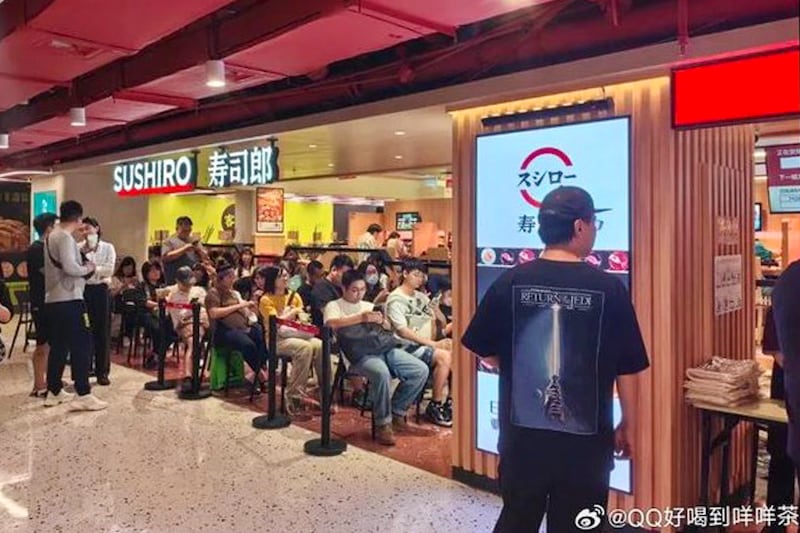Just a year ago, Chinese social media was awash with anti-Japanese sentiment, with nationwide boycotts of Japanese restaurants following the release of wastewater from the crippled Fukushima nuclear plant into the ocean.
But in recent days, diners have been ignoring safety fears, lining up for hours to eat at the Japanese sushi chain Sushiro, which offers plates of sushi on a conveyor belt, despite widespread import bans and safety inspections by authorities in China and Hong Kong, according to multiple media reports.
According to a video report from Japan's TBS News Dig, dozens of people were waiting in chairs at the newly opened branch in Xidan Joy City, with waiting times advertised at "upwards of 180 minutes," according to a sign at the store.
Diners were attracted by the relatively low prices, which range from 10 yuan (US$1.4) to 28 yuan (US$4) per plate of sushi, as well as a pledge to use only Chinese produce following the import bans, the reports said.
"Since the release of treated water from the Fukushima Daiichi nuclear power plant, Japanese restaurants that handle seafood have been facing headwinds," the TBS News Dig report said. "But conveyor belt sushi, where you can enjoy Japanese food at a low price, is becoming more and more popular."
While Sushiro, owned by Japan's Food & Life Companies, already has more than 40 branches across China, it is still seeking further expansion, according to state-backed English-language newspaper the China Daily.
"Unlike other restaurants, we launched self-ordering digital screens and the conveyor belt system for food delivery for each table at the Beijing restaurant, making the ordering process more fun and convenient," the paper quoted Kazunari Matsuda, general manager of Beijing Sushiro Restaurants, as saying in an Aug. 22 report.

"A sushi train restaurant is more suitable for dine-in experiences, given its unique features,” Matsuda said. “A large proportion of our customers are aged between 18 and 35, including college students and office workers. At our restaurants in Shenzhen and Tianjin, we have also seen many foreign guests from Europe and the United States.”
The COVID-19 pandemic did not significantly affect its operations, and the brand has stuck to in-store cooking, instead of relying on central kitchens, he said.
Sushiro also operates some 30 restaurants in Hong Kong and more than 40 outlets in Taiwan, with more than 800 outlets across East Asia, including Thailand and Singapore.
Online debate
The reports prompted heated online discussions, with one comment in Japanese under a report from TV Tokyo saying that the lines of diners spoke volumes about the safety of Japanese food, while comments in China ridiculed people for flocking to the store, saying they had "poor judgment."
The proprietor of a Japanese restaurant in Hong Kong who identified himself as Master Kong said his business was hard hit by the mass outpouring of anti-Japanese sentiment by " little pink" supporters of the Chinese government last year.
While there have been signs of improvement over the last six months, he has closed two out of four of his branches in the city, citing a recent report in Hong Kong's Ming Pao newspaper as saying that around one third of Japanese restaurants in Hong Kong closed during the past year.
Master Kong believes that, even if the Hong Kong government lifts the import ban on Japanese seafood, it won't improve business by much in the current economic climate.
"A lot of restaurants have been unable to survive and have closed down," he said. "I don't think there'll be a sudden rush of business just from freeing up [those restrictions]."
He said the seafood bans currently only apply to the Kanto region, and that his restaurants are still able to source ingredients from Kansai and Hokkaido, although deliveries can sometimes be delayed by the authorities at the airport, who insist on taking them for radiation testing.
Yet he doesn't see the bans as the main reason behind the disappearance of so many Japanese restaurants in the city.
"I don't think we're going to see the gradual reappearance of Japanese restaurants in Hong Kong," Kong said, citing a growing tendency among Hong Kongers to venture across the border into China for their culinary adventures.
Hong Kongers have also recently flocked to Taiwan and Japan itself to enjoy the local cuisine and stock up on supplies.
He said many in the city had gotten into the habit of ordering in during the pandemic restrictions.
"This is a problem, because they can just press a button in an app and get it delivered just like that," he said. "They won't sit down and order a bottle of sake or try some imported foods."
"They just want to fill their stomachs."
Translated with additional reporting by Luisetta Mudie. Edited by Malcolm Foster.
